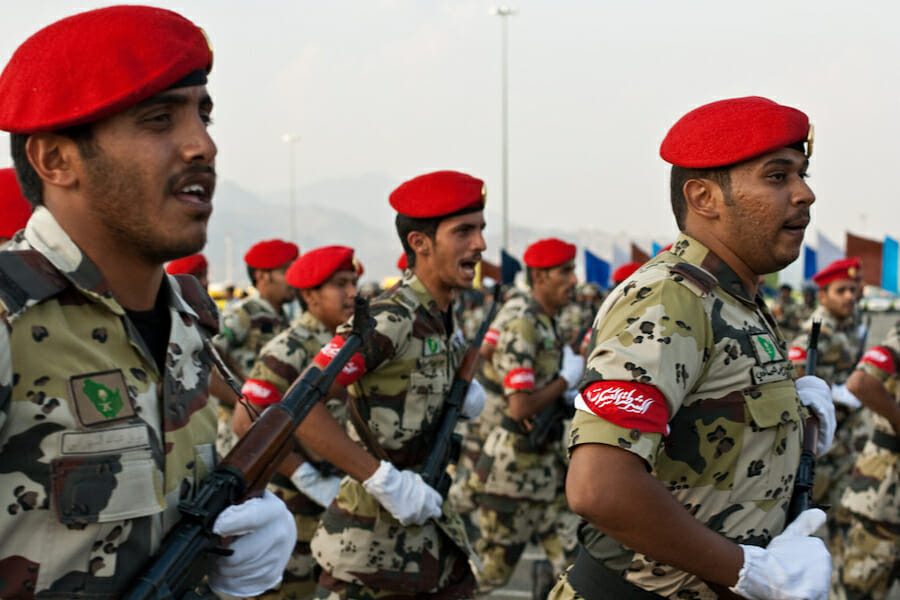
Houthis a Potent Enemy for Saudis
Recent attacks launched by Houthis rebels on critical installations in Saudi Arabia has demonstrated a significant leap in their capabilities. The story of how Ansar Allah (the official name of Houthi movement) moved from small-arms ambushes to medium-range ballistic missile and sophisticated drone attacks deep inside enemy territory in just half a decade illustrates how an ambitious militant group can capture and use a state’s arsenals and benefit from Iran’s support. With every passing day, the Houthi movement is proving itself to be a very tough military opponent for the government of ousted Yemeni President Abdrabbuh Mansour Hadi and his Saudi sponsors.
Fourteen years of conflict have strengthened the Houthis, and they are thriving under the conditions of war. Since the early 2000s, and especially in the past four years of conflict, the Houthis have transformed from a small-scale rebel group warring in Yemen’s extreme north to central participants in perhaps the most significant regional conflict in the history of the modern Arabian Peninsula and the world’s deadliest war today. Today, the Houthis are taking on and posing great threats to Saudi Arabia, which is flush with Western weapons and oil money.
In mid-May, the Houthis drone warfare reached a new level of sophistication. Drone attacks on a Saudi oil pipeline west of Riyadh came as a surprise to the Saudis. The Aramco East-West pipeline, stretching across the country to the port and oil terminal at Yenbu, was damaged at two places as pumping stations were hit. These bold attacks show that the Houthis have taken a different trajectory of economic warfare towards the Saudis. In March of this year, the Houthis released video footage of a drone flying past Saudi’s al-Shuqaiq water treatment and power plant. Houthis are clearly sending a message to their big neighbour that they are capable of threatening their key installations. Moreover, Houthis through use of re-engineered Chinese commercial drones and Iranian military UAVs, like the Qasef-1 model, regularly harass the Saudis anti-missile systems. Saudi officials admit that Houthis’ technology has quickly evolved from small, propeller-powered surveillance drones to a larger plane-shaped model, named UAV-X by United Nations investigators, that can travel more than 900 miles at a speed of 150 miles-per-hour. This is a matter of concern for Saudi Arabia as now Ansar Allah can strike at their core. There is a high possibility that the next round of the Houthis-Saudis conflict will spread deep inside the Kingdom and to shipping lanes in the Red Sea.
Ansar Allah also turned out to be successful in the raiding war along the Saudi-Yemeni border, where it has fought a Hezbollah-style guerrilla campaign against Saudi border forces. Houthi forces have achieved great tactical success against Saudi border posts through offensive mine-laying on supply routes and Anti-Tank Guided Missiles (ATGM) strikes on armoured vehicles and outposts. Houthis also have their own in-house weapons production facilities.
A number of small-scale military industries have been established since 2014 to support the war effort and maximize domestic reuse and production capabilities in order to minimize the effect of the international arms embargo on the Houthi movement. A land-mine production facility was established in Sa’ada, for feeding distribution hubs in Sana’a, Hodeida, and Dhamar. In Hodeida, a drone workshop operates, drawing on a supply of rolls of fiberglass to make airframes. In addition to this, the Houthis have smoothly absorbed the new missile and rocket systems. Moreover, these weapons have an effective deployment and launch system through Iranian training and technical assistance. Now the Houthis are not totally dependent on Iran to carry out these long-range attacks on Saudi Arabia.
The Houthis have also been strengthened from missteps by the Arab coalition and the Yemeni government. The Arab coalition’s negligent airstrikes against previously unaligned tribes has given the Houthis new allies which ensure them constant supplies of new fighters. So rather than escalating this conflict to new heights, the Saudis should engage the Houthis and form a functional relationship with them. The Saudis can then take help from regional countries which have credibility and legitimacy such as Oman. There is also a good reason to start this initiative as the Houthis have long privately signaled an interest in direct talks with the Saudis, rather than with the Hadi government, which they know has a limited political life. Moreover, significant numbers of Houthi leaders understand that a political accommodation with the great neighbour across the border is far more beneficial for their community’s ultimate survival rather than a relationship with a partner of convenience, Iran, which is physically distant and has very few non-military resources to offer. Hence a Saudi-led diplomatic maneuver to engage Houthis directly would offer a much-needed, middle way to end this disastrous war which is taking a heavy toll on the Yemenis and also threatens the stability of the whole Arabian Peninsula.

